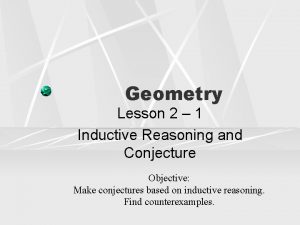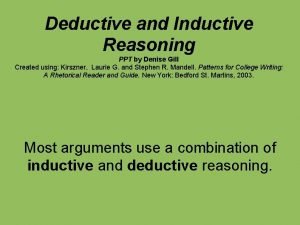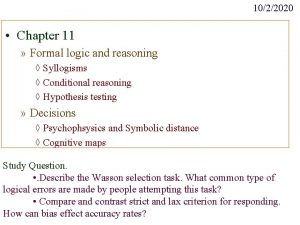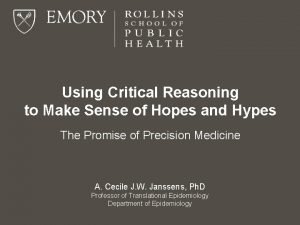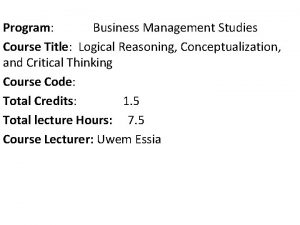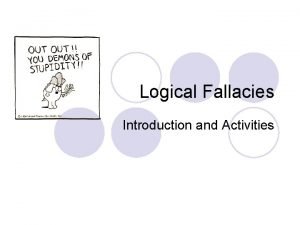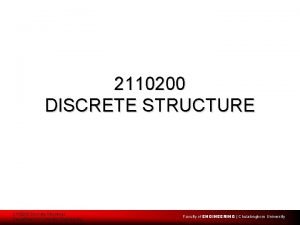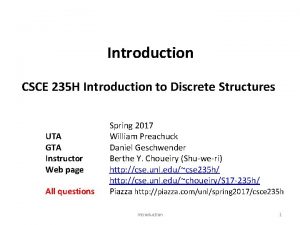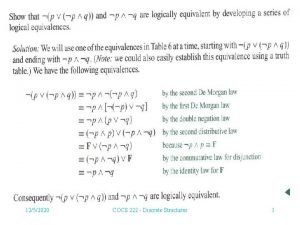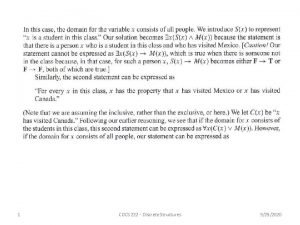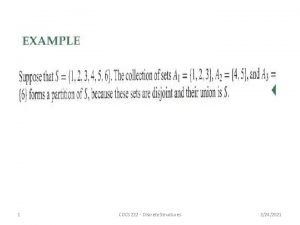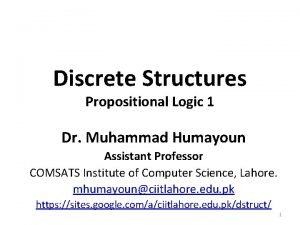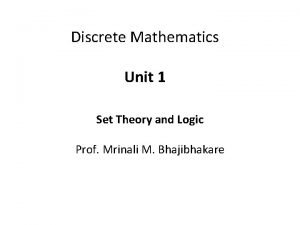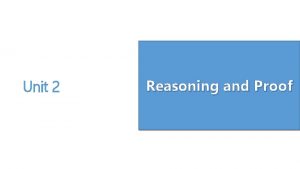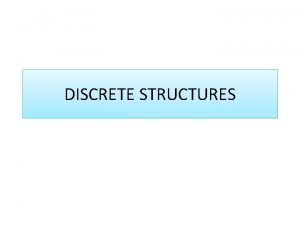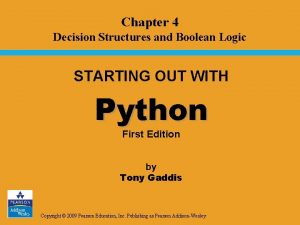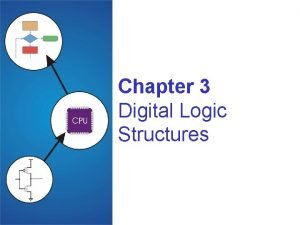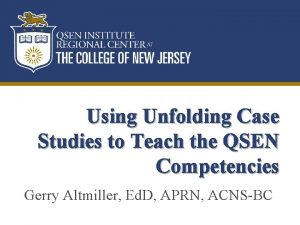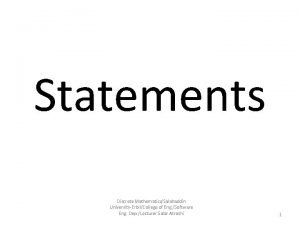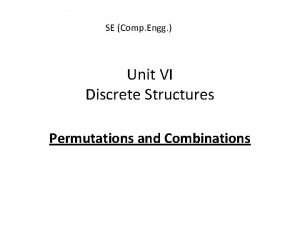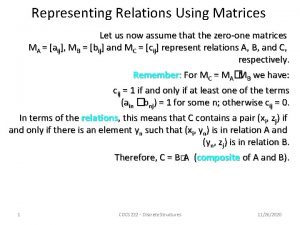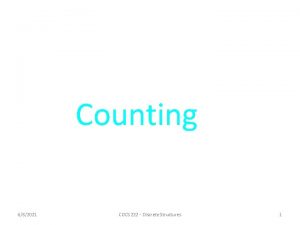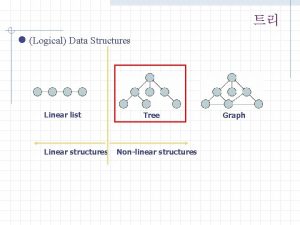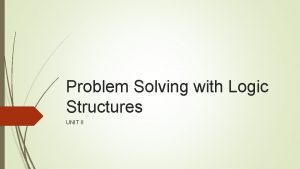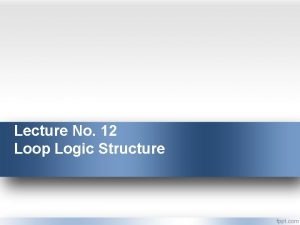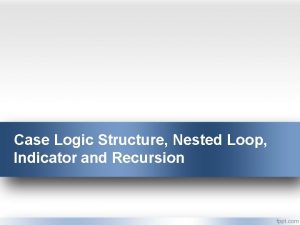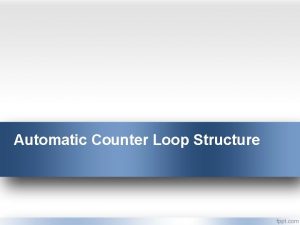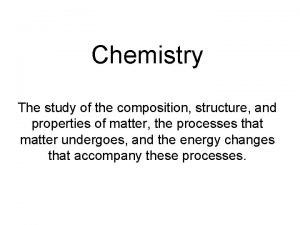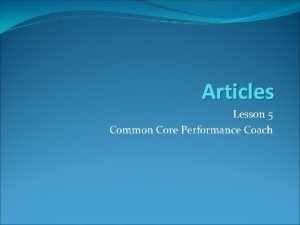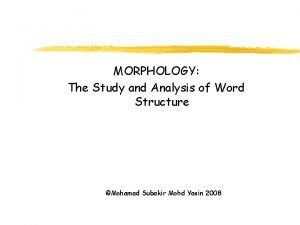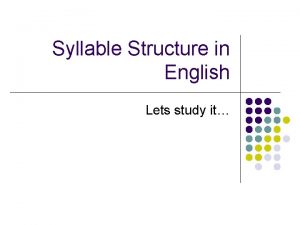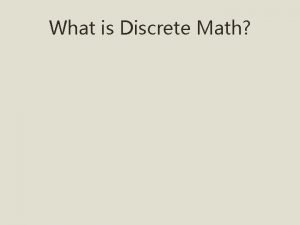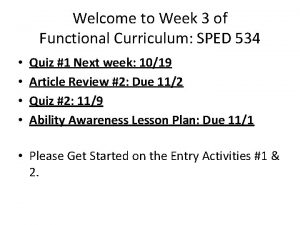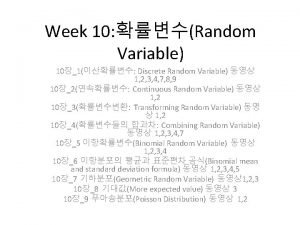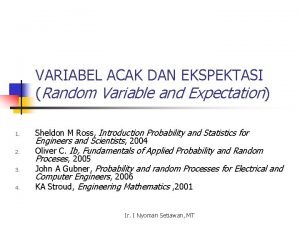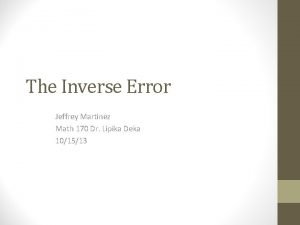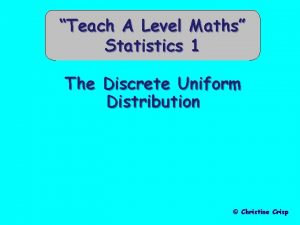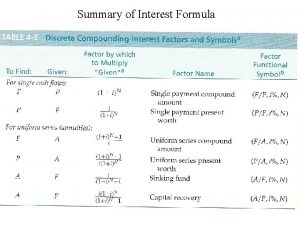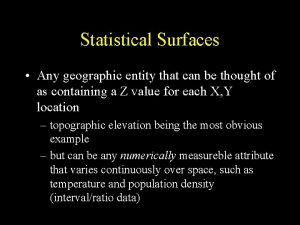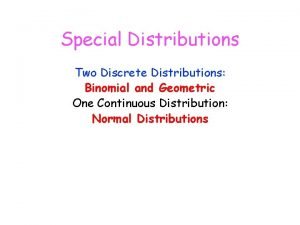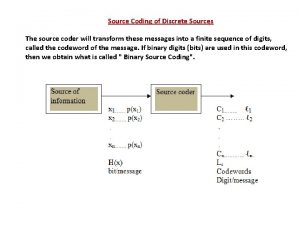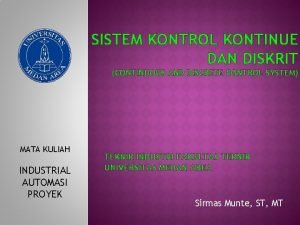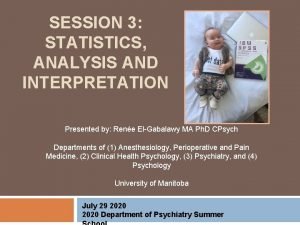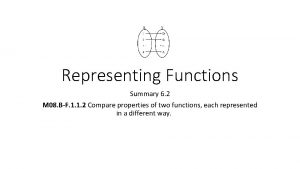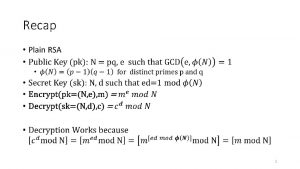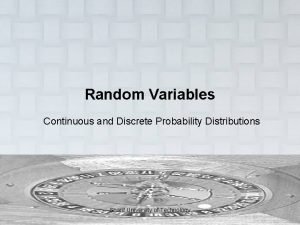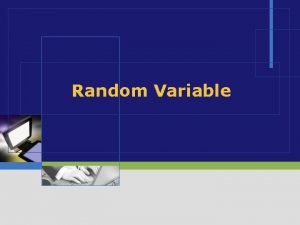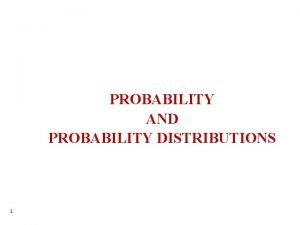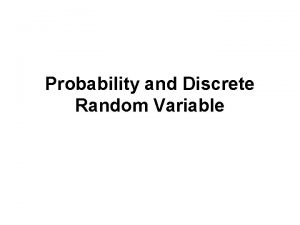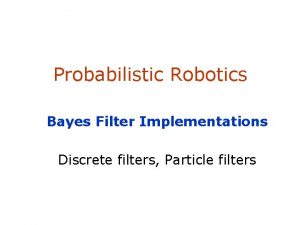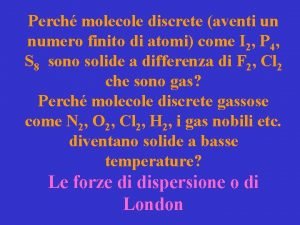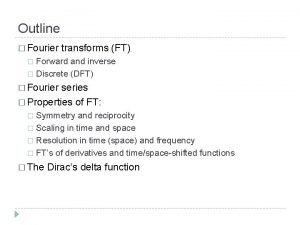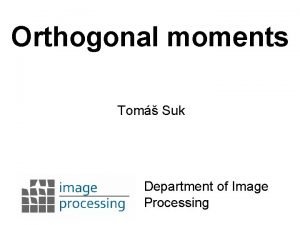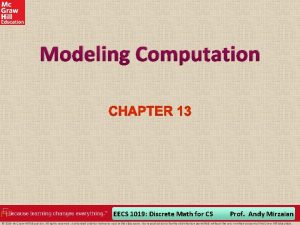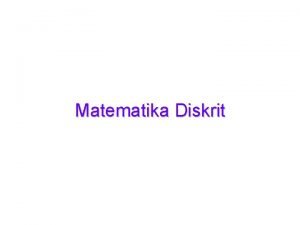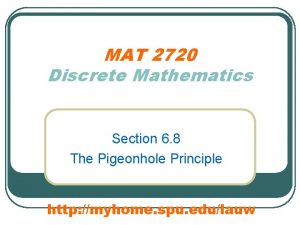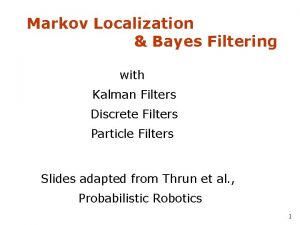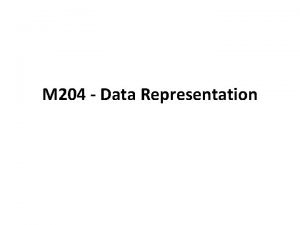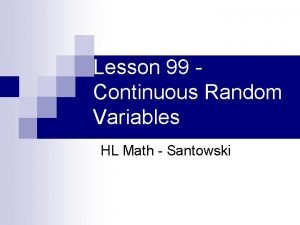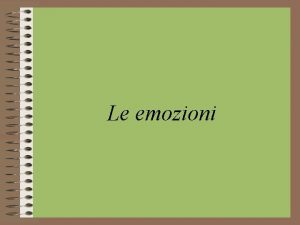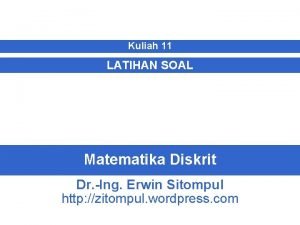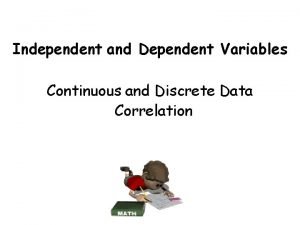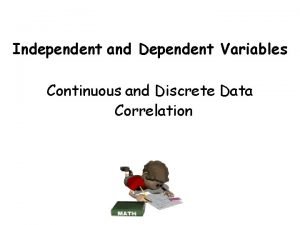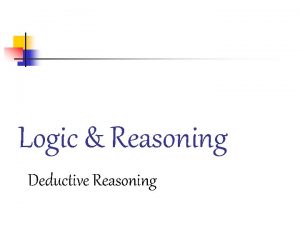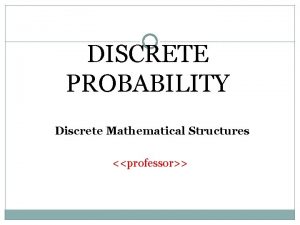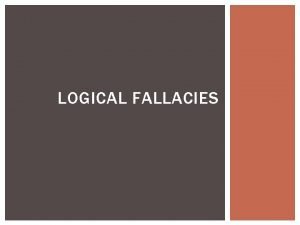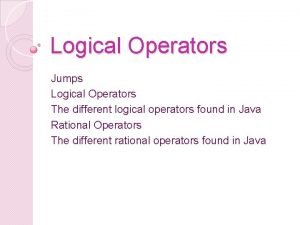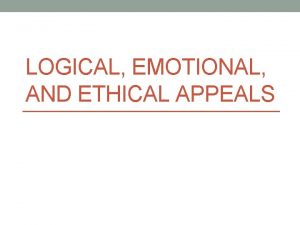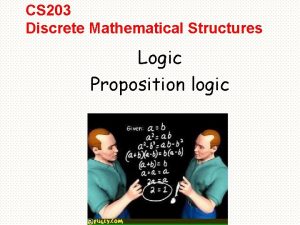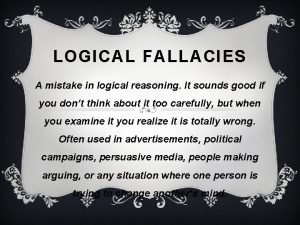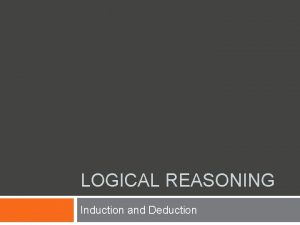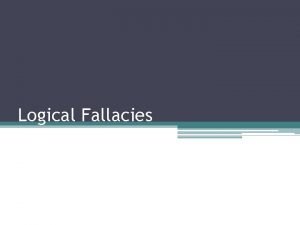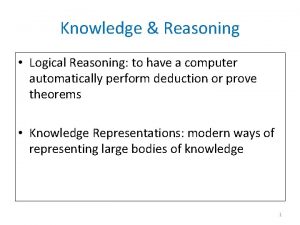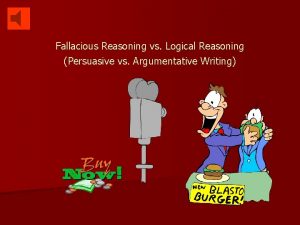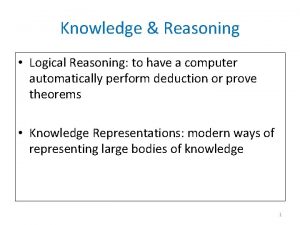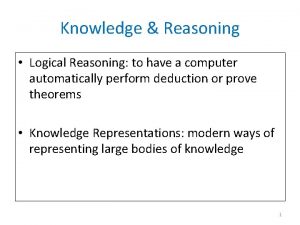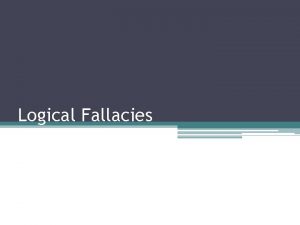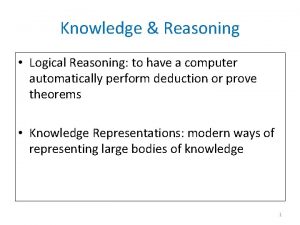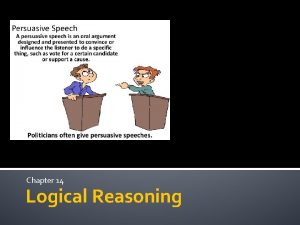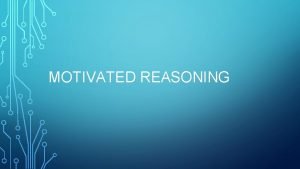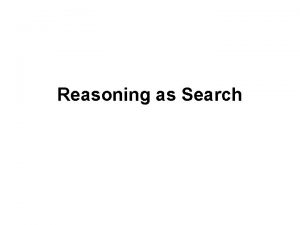DISCRETE STRUCTURES LOGICAL STRUCTURE Logic study of reasoning




































































































- Slides: 100

DISCRETE STRUCTURES

LOGICAL STRUCTURE • Logic - study of reasoning - focuses on the relationship among statements as opposed to the content of any particular statement. Logical methods are used in mathematics to prove theorems and in computer science to prove that programs do what they are alleged to do. ex. All mathematicians wear sandals. Anyone who wears sandals is an algebraist. Therefore, all mathematicians are algebraist.

LOGICAL STRUCTURE Propositions – A sentence that is either true or false, but not both. Examples: • 1+1=3 • 2+2=4 - A fact-based declaration is a proposition, even if no one knows whether it is true.

LOGICAL STRUCTURE - A statement cannot be true or false unless it is declarative. This excludes commands and questions. examples: • What time is it? • Go home.

LOGICAL STRUCTURE Definition Let p and q be propositions • The conjunction of p and q, denoted by p ᴧ q, is the proposition p and q • The disjunction of p and q, denoted p ᴠ q, is the proposition p or q

LOGICAL STRUCTURE Compound proposition – combination of propositions Example : p: 1+1 = 3 q: a decade is 10 years then: conjunction: p ᴧ q : 1+1 = 3 and a decade is 10 years. disjunction: p ᴠ q : 1+1 = 3 or a decade is 10 years

LOGICAL STRUCTURE Each sentence or the propositions has a truth value of either true or false. The truth values of propositions can be described by truth tables.

LOGICAL STRUCTURE Definition The truth value of the compound proposition p ᴧ q is defined by the truth table p q pᴧq T T F F F T F F - states that the conjunction p ᴧ q is true provided that p and q are both true; p ᴧ q is false otherwise.

LOGICAL STRUCTURE Definition The truth value of the compound proposition p ᴠ q is defined by the truth table p q pᴠq T T F F F - states that the disjunction p ᴠ q is true if either p or q or both are true; false if both p and q are false

LOGICAL STRUCTURE Definition The negation of p denoted by ¬p is the proposition not p. The truth value of the proposition ¬p is defined by the truth table p ¬p T F F T In other words, the negation of a proposition has the opposite truth value from the proposition itself.

LOGICAL STRUCTURE Example p: Blaise Pascal invented several calculating machines. q: The first all-electronic digital computer was constructed in the 20 th century. r: П was calculated to 1 M decimal digits in 1954

LOGICAL STRUCTURE • represent the proposition: Either Blaise Pascal invented several calculating machines and it is not the case that the first all electronic digital computer was constructed in the 20 th century; or П was calculated to 1 M decimal digits in 1954.

LOGICAL STRUCTURE Definition: If p and q are propositions, the compound propositions if p then q is called conditional proposition and is denoted by p→ q. • The proposition p is called the hypothesis (or antecedent) and the proposition q is called the conclusion (or consequent)

LOGICAL STRUCTURE example: p: The Math Dept. gets an additional Php 200, 00. q: The Math Dept. hires one new faculty member p→ q: If the Math Dept. gets an additional Php 200, 000, then it will hire one new faculty member.

LOGICAL STRUCTURE p→ q • if p then q • p implies q (q is implied by p) • whenever p, q (q whenever p) • q unless ¬p • p only if q (if not q then not p) • ¬q implies ¬p • p is a sufficient condition for q • q is a necessary condition for p

LOGICAL STRUCTURE examples 1. If 3+3=7, then you are the pope. 2. If the Lakers win the NBA, then they sign Artest. A necessary condition for the Lakers to win the NBA is that they sign Artest. 3. If John takes calculus, then he passed algebra. John may take calculus only if he passed algebra. 4. If Jane goes to EK, then she visits Laguna. A sufficient condition for Jane to visit Laguna is that she goes to EK.

LOGICAL STRUCTURE Definition: The truth value of the conditional proposition p→ q is defined by the following truth table. p q p→q T T F F F T T F F T

LOGICAL STRUCTURE Examples: 1. p: 1>2 False q: 4<8 True p→ q ? q→ p ? 2. Given p is true, q is false, r is true, find the truth value of: a. (pᴧq)→r b. (pᴠq)→¬r

LOGICAL STRUCTURE NOTE: • Converse: The proposition q→ p is the converse of the proposition p→ q. • Inverse: The proposition ¬p→¬q is the inverse of the proposition p→ q. • Contrapositive: The contrapositive (or transposition) of the conditional proposition p→ q is the proposition ¬q→¬p.

LOGICAL STRUCTURE Example: “The home team wins whenever it is raining” (“If it is raining, then the home team wins. ”) Converse: “ If the home team wins, then it is raining. ” Inverse: “ If it is not raining, then the home team does not win. ” Contrapositive: “If the home team does not win, then it is not raining. ”

LOGICAL STRUCTURE Definition If p and q are propositions, the compound proposition p if and only if q is called a biconditional proposition and is denoted by p↔ q.

LOGICAL STRUCTURE p↔ q • p is equivalent to q • p iff q • p is a sufficient and necessary condition for q • p →q and q→ p (p implies q and q implies p)

LOGICAL STRUCTURE Definition The truth value of the proposition p↔ q is defined by the following truth table. p q p↔q T T F F F T Example: 1<5 iff 2<8

LOGICAL STRUCTURE Derfinition Suppose that the compound propositions P and Q are made up of the propositions p 1, p 2, …, pn. We say that P and Q are logically equivalent and write P ≡ Q , provided that given any truth values of p 1, p 2, …, pn , either P and Q are both true or P and Q are both false.

LOGICAL STRUCTURE example: 1. De Morgan’s Laws for Logic ¬ (pᴠq) ≡ ¬p ᴧ ¬q 2. ¬(p→q) ≡ pᴧ¬q 3. State whether P ≡ Q a. P = pᴧ(¬qᴠr) ; Q = pᴠ(qᴧ¬r) b. P = (p→q)→r ; Q = p→(q→r) Note: The conditional proposition p→q and its contrapositive ¬q→¬p are logically equivalent.

LOGICAL STRUCTURE Exercises: A. Let p, q, r be the following sentences p: John is at the office. q: Joan is at the office. r: Laura is at the office. Use logical connectives to express the following sentences: 1. John is not at the office. 2. If Joan and Laura are at the office then John is at the office.

LOGICAL STRUCTURE 3. If John is at the office then either Joan or Laura is at the office. 4. John, Joan and Laura are all at the office. 5. Joan is not at the office and either John or Laura are at the office. 6. If Laura is not at the office then John and Joan are both at the office.

LOGICAL STRUCTURE B. Translate the following into logical expression. 1. “ You can access the internet from campus only if you are a computer science major or you are not a freshman. ” 2. “ You cannot ride the roller coaster if you are under 4 feet tall unless you are older than 16 years old. ”

LOGICAL STRUCTURE C. Solve a Crime Four friends have been identified as suspects for an unauthorized access into a computer system. They have made statements to the investigating authorities. Alice said “Carlos did it. ” John said “ I did not do it. ” Carlos said “ Diana did it. ” Diana said “Carlos lied when he said that I did it. ” If the authorities also know that exactly one of the four suspects is telling the truth, who did it?

LOGICAL STRUCTURE Theorem The following list of logically equivalent properties can be established using truth tables. 1. Indempotent Laws pᴧp ≡ p pᴠp ≡ p 2. Double Negation ¬(¬p) ≡ p 3. De Morgan’s Laws ¬ (pᴠq) ≡ ¬p ᴧ ¬q ¬ (pᴧq) ≡ ¬p ᴠ ¬q 4. Commutative properties pᴧq ≡ qᴧp pᴠq ≡ qᴠp

LOGICAL STRUCTURE 5. Associative properties pᴧ(qᴧr) ≡ (pᴧq)ᴧr pᴠ(qᴠr) ≡ (pᴠq)ᴠr 6. Distributive properties pᴧ(qᴠr) ≡ (pᴧq)ᴠ(pᴧr) pᴠ(qᴧr) ≡ (pᴠq)ᴧ(pᴠr) 7. Equivalence of Contrapositive p→q ≡ ¬q→¬p 8. Other useful properties p→q ≡ ¬pᴠq p↔q ≡ (p→q)ᴧ(q→p)

LOGICAL STRUCTURE QUANTIFIERS Definition Let P(x) be a statement involving the variable x and let D be a set. We call P a propositional function (with respect to D) if for each x in D, P(x) is a proposition. We call D the domain of discourse of P.

LOGICAL STRUCTURE P(x): value of the propositional function P of x. Example: “x>5” these statement is not a proposition because whether it is true or false depends on the value of x. Once a value has been assigned to the variable x, the statement P(x) becomes a proposition and has a truth value.

LOGICAL STRUCTURE In general, a statement involving n variables x 1, x 2, …, xn can be denoted by P(x 1, x 2, …, xn ). A statement of the form P(x 1, x 2, …, xn ) is the value of the propositional function P at the n-tuples (x 1, x 2, …, xn ) and P is also called a predicate.

LOGICAL STRUCTURE To create proposition from a propositional function: • Assign values to the variables • Quantification types: 1. universal quantification 2. existential quantification

LOGICAL STRUCTURE Definition The universal quantification of P(x) is the proposition “P(x) is true for all values of x in the domain of discourse. ” Notation: • denotes the universal quantification of P(x) • called the universal quantifier • read as “for all x P(x)” ; “for every x P(x)” • true if P(x) is true for every x • false if P(x) is false for at least one x in the Domain

LOGICAL STRUCTURE Examples: Domain for x is the set of real numbers 1. P(x): “x+1>x” 2. P(x): “x>5” 3. Q(x): “x 2 >= x” Note: is false if P(x) is false for at least one x in D. A value x in the domain of discourse that makes P(x) false is called a counterexample to the statement .

LOGICAL STRUCTURE Definition The existential quantification of P(x) is the proposition “There exist an element x in the domain of discourse such that P(x) is true. Notation: • denotes the existential quantification of x • is called the existential quantifier • read as “there is an x s. t. P(x)” “there is at least one x s. t. P(x)” “for some x, P(x)”

LOGICAL STRUCTURE • true if P(x) is true for at least one x in the domain • false if P(x) is false for every x in the domain Examples: Domain is the set of real numbers 1. P(x): x>3 2. Q(x): x = x+1 3. P(x):

LOGICAL STRUCTURE Exercises. Give the domain. 1. 2. True or False. Domain is the set of integers. P(x): x>2 Q(x): x<2 1. 2.

LOGICAL STRUCTURE Negation with Quantifiers example : Every student in the class has taken a course in calculus. P(x) : “x has taken a course in calculus” Negation of : • It is not the case that every student in the class has taken a course in calculus. • There is a student in the class who has not taken a course in calculus. :

LOGICAL STRUCTURE Example : There is a student in this class who has taken a course in calculus. Q(x) : “x has taken a course in calculus” Negation of • It is not the case that there is a student in this class who has taken a course in calculus. • Every student in this class has not taken calculus. :

LOGICAL STRUCTURE RULES of INFERENCE Definition (Argument) An argument is a sequence of propositions written as. The propositions p 1, p 2, …, pn are called the hypotheses (or premises), and the proposition q is called the conclusion. The argument is valid provided that if p 1 andp 2 and pn are all true, then q must also be true; otherwise, the argument is invalid (or a fallacy).

LOGICAL STRUCTURE Rules of inference- brief and valid argument used within a larger argument such as proof Example Determine whether the argument is valid. p→q p q D: Discrete. MathQUANTIFIERS. doc

LOGICAL STRUCTURE Example (A Logical Argument) If I dance all night, then I get tired. I danced all night. Therefore I got tired. Logical representation of the underlying variables: p: I dance all night. q: I get tired. Logical analysis of the argument: p→q p q

LOGICAL STRUCTURE If I dance all night, then I get tired. I got tired. Therefore I danced all night. Logical form of argument: p→q q p

LOGICAL STRUCTURE Examples: 1. Show that the hypotheses “ If you send me an email message, then I will finish writing the program, ” If you do not send me an email message, then I will go to sleep early, ” and “If I go to sleep early, then I will wake up feeling refreshed “ lead to the conclusion “If I do not finish writing the program, then I will wake up feeling refreshed. ”

LOGICAL STRUCTURE 2. Show that the hypotheses "It is not sunny this afternoon and it is colder than yesterday, " "We will go swimming only if it is sunny, " "If we do not go swimming, then we will take a canoe trip, " and " If we take a canoe trip, then we will be home by sunset" lead to the conclusion "We will be home by sunset. "

FUNCTIONS

FUNCTIONS Definition Let A and B be sets. A function f from A to B is an assignment of exactly one B element to each element of A . We write f(a)=b if b is the unique element of B assigned by the function f to the element a of A. If is a function from A to B, we write f: A→B.

FUNCTIONS Definition If f is a function from A to B, we say that A is the domain of f and B is the codomain of f. If f(a)=b, we say that b is the image of a and a is a pre-image of b. The range of f is the set of all images of elements of A. Also, if f is a function from A to B , we say that f maps A to B.

FUNCTIONS A function f from A to B is said to be one-toone, or injective if for each bϵ B, there is at most one aϵA with f(a)=b. A function is said to be an injection if it is one-to-one. A function f from A to B is called onto, or surjective if and only if for every element bϵB there is an aϵA element with f(a)=b . A function is said to be surjection if it is onto.

FUNCTIONS The function f is a one-to-one correspondence, or bijection, if it is both one-to-one and onto. Example: Let S={1, 2, 3, 4, 5} and T={a, b, c, d}. For each question below if your answer is yes, give an example; if your answer is no, explain briefly. 1. Are there any one-to-one functions from S to T? 2. Are there any functions mapping S onto T? 3. Are there any one-to-one correspondences between S and T?

FUNCTIONS Definition(Inverse) Let f be a one-to-one correspondence from the set A to the set B. The inverse function of f is the function that assigns to an element b belonging to B the unique element a in A such that f(a)=b. The inverse function of f is denoted by f¯¹. Hence, f¯¹ (b)=a when f(a)=b.

FUNCTIONS Definition(Composition) Let g be a function from the set A to the set B and let f be a function from the set B to the set C. The composition of the functions f and g , denoted by f◦g is defined by (f◦g)(a)=f(g(a)). (not defined unless the range of g is a subset of the domain of f)

FUNCTIONS Examples: Let A= {1, 2, 3, 4, 5} B={6, 7, 8, 9} C={10, 11, 12, 13} D={□, ∆, ◊, ∂} Let R Ax. B, S Bx. C and T Cx. D be defined by R = {(1, 7), (4, 6), (5, 6), (2, 8)} S = {(6, 10), (6, 11), (7, 10), (8, 13)} T = {(11, ∆), (10, ∆), (13, ∂), (12, □), (13, ◊)} Compute the relations

FUNCTIONS Definition The floor function that assigns to the real number x is the largest integer that is less than or equal to x. The value of the floor function at is denoted by Lx˩. The ceiling function assigns to the real number x the smallest integer that is greater than or equal to x. The value of the ceiling function at is denoted by Гx˥.

COMBINATORIAL STRUCTURES

COUNTING Examples 1. How many positive integers of two different digits can be formed from the integers 1, 2, 3, and 4? 2. How many different arrangements of six distinct books each can be made on a shelf with space for six books?

COUNTING Multiplication Principle If an activity can be constructed in t successive steps and step 1 can be done in n 1 ways, step 2 can be done in n 2 ways, … , and stept can be done in nt ways, then the number of different possible activities is n 1∙n 2∙∙∙nt

COUNTING Example Given: APPETIZERS Nachos Salad MAIN COURSES Hamburger Cheeseburger Fish Fillet BEVERAGES Tea Milk Soda Root Beer 1. List all possible dinners consisting of one main course and one beverage. 2. List all possible dinners consisting of one appetizer, one main course and one beverage. 3. List all possible dinners consisting of one main course and an optional beverage.

COUNTING Examples 1. How many different arrangements of each consisting of four different letters can be formed from the letters of the word “PERSONAL” if each arrangement is to begin and end with a vowel. 2. Suppose that three of six books are math books and three art books. a. How many different arrangements of the six books can be made on the shelf if book on the same subject are to be kept together?

COUNTING b. How many different arrangements of the six books can be made on the shelf if math books are to be kept together but three art books can be placed anywhere? 3. In how many ways can we select two books from different subjects among five distinct computer science books, three distinct math books and two distinct art books?

COUNTING Definition (Permutation) A permutation of n distinct elements x 1, …, xn is an ordering of the n elements x 1, …, xn.

COUNTING Definition (Permutation) Let S be a set containing n elements and suppose r is a positive integer such that r≤n. Then a permutation of r elements of S is an arrangement in a definite order, without repetitions, of r elements of S. notations: n. Pr; P(n, r); Pn, r ; “permutations of n taken r”

COUNTING Theorem The number of permutations n of elements taken r at a time is given by either of the following formulas: a. n. Pr = n(n-1)(n-2)…(n-r+1) b. n. Pr = n!/(n-r)!

COUNTING Example 1. A bus has seven vacant seats. If three additional passengers enter the bus, in how many ways can they be seated? 2. In how many ways can four boys and four girls be seated in a row containing eight seats if a) a person may sit in any seat b) boys and girls must alternate seats

COUNTING Theorem If we are given n element, of which exactly m 1 are alike of one kind, exactly m 2 are alike of a second kind, …, and exactly mk are alike of the kth kind, and if n = m 1 + m 2 +…+ mk then the number of distinguishable permutations that can be made of the n elements taking them all at one time is .

COUNTING Example 1. How many strings can be formed using the following letters MISSISSIPPI? 2. How many different signals each consisting of eight flags hung one above the other , can be formed from a set of three indistinguishable red flags, two indistinguishable blue flags, two indistinguishable white flags and one black flag?

COUNTING Definition(Combination) Let S be a set containing n elements and suppose r is a positive integer such that r < n. Then a combination of r elements of S is a subset of S containing r distinct elements.

COUNTING Theorem The number of combinations of n elements taken r at a time is given by n. Cr = n. Pr / r! = n! /(n-r)! r!

COUNTING Example 1. A football conference consists of eight teams. If each team plays every other team, how many conference games are played? 2. A student has ten posters to pin up on the walls of her room, but there is space for only seven. In how many ways can the student choose the posters to be pinned up?

COUNTING 3. In how many ways can we select a committee of two women and three men from a group of 5 distinct women and 6 distinct men? 4. How many poker hands contain cards all of the same suit? 5. From 6 history books and 8 language books, in how many ways can a person select two history books and three language books and arrange them on a shelf?

COUNTING Binomial Theorem If n is any positive integer, then

PROBABILITY • • Random experiment Sample space Event as a subset of sample space Likelihood of an event to occur- probability of an event

PROBABILITY Features of a Random Experiment • all outcomes are known in advance. • The outcome of any one trial cannot be predicted with certainty. • Trials can be repeated under identical conditions.

PROBABILITY Examples (Random Experiment) • Rolling a die and observing the number of dots on the upturned face. • Tossing a coin and observing the upturned face.

PROBABILITY Sample Space It is a set such that each element denotes an outcome of a random experiment. It is usually denoted by Ω or S. Example. Rolling a die and observing the number of dots on the upturned face. S = {1, 2, 3, 4, 5, 6}

PROBABILITY Event A subset of the sample space whose probability is defined. Example S = {1, 2, 3, 4, 5, 6} a. An event of observing odd number of dots in a roll of a die : E 1 = {1, 3, 5} b. An event of observing even number of dots in a roll of a die : E 2 = {2, 4, 6}

PROBABILITY Two events are mutually exclusive if the two events cannot occur simultaneously. Example Coin toss: either a head or a tail, but not both. The events head and tail are mutually exclusive.

PROBABILITY Definition(Probability) The probability of an event E , which is a subset of a finite sample space S of equally likely outcomes is P(E) = |E|/|S| note: A probability function P assigns to each outcome x in a sample space S a number P(x) so that 0 < P(x) < 1 for all x in S and ∑ P(x) = 1.

PROBABILITY Example: If we select a card at random from a well shuffled deck of cards then, P(ace in a deck of cards)= 4/52 Note: Probability of a joint event, A and B P(A and B) = P(A∩B) Example P(red card and Ace) = 1/26

PROBABILITY Theorems 1. Let E be an event. The probability of Ē, the complement of E , satisfies P(E) +P(Ē) = 1. 2. Let E 1 and E 2 be events. Then P(E 1 U E 2) = P(E 1) + P(E 2) – P(E 1∩ E 2) note: If E 1 and E 2 are mutually exclusive events, P(E 1 U E 2) = P(E 1) + P(E 2)

PROBABILITY Exercises 1. Find errors in each of the ff assignments of probabilities. a. The probabilities that a student will have 0, 1, 2, or 3 or more mistakes are 0. 51, 0. 47, 0. 24, and -0. 12 respectively. b. The probability that it will rain tomorrow is 0. 46 and the probability that it will not rain tomorrow is 0. 55.

PROBABILITY 2. P(King or Spade) 3. P(King or Queen) 4. If two dice are thrown, what is the probability of obtaining sum of 7? of 5? 5. What is the probability of obtaining a sum of 7 or 5 if the two dice are thrown?

PROBABILITY Definition(Conditional Probability) Let E and F be events with P(F)>0. The conditional probability of E given F , denoted by P(E|F) is defined as P(E|F) = P(E∩F)/P(F) note: If E and F are independent events P(E) = P(E|F) The events E and F are independent if and only if: P(E∩F) = P(E)P(F)

PROBABILITY From a deck of 52 cards, P(Ace|red) = ? A Deck of 52 cards Type Ace Non-Ace Total Color Red Black 2 2 24 24 26 26 Total 4 48 52

PROBABILITY Example: What is the probability of getting a sum of 10, given that at least one die shows 5, when two fair dice are rolled?

PROBABILITY Solution: Let E be the event of getting a sum of 10 F be the event that at least one die shows 5 P(E∩F) – probability of getting a sum of 10 and at least one die shows 5

PROBABILITY Example: Weather records shows that the probability of high barometric pressure is 0. 80, and the probability of rain and high barometric pressure is 0. 10. What is the probability of rain given high barometric pressure?

PROBABILITY Solution: R – denotes the event of “rain” H – denotes the event of “ high barometric pressure”

PROBABILITY Example (Independent Events) 1. Tossing a coin: What is the probability that head on first toss and tail on second? 2. Are the events that a family with 3 children has children of both sexes, and that a family with three children has at most one boy, independent? Assume that the eight ways a family can have 3 children are equally likely.

PROBABILITY 3. Joe and Olivia take a final exam in discrete structures. The probability that Joe passes is 0. 70 and the probability that Olivia passes is 0. 95. Assuming that the events “Joe passes” and “Olivia passes” are independent, find the probability that Joe or Olivia passes or both passes the final exam?

PROBABILITY Baye’s Theorem Suppose that the possible classes are C 1, …, Cn. Suppose further that each pair of classes is mutually exclusive and each item to be classified belongs to one of the classes. For a feature set F, we have

PROBABILITY Example 1. At a call center company, David, Rose, and Lea make calls. The following table shows the percentage of calls each caller makes and the percentage of persons who are annoyed and hang up on each call. Caller % calls % hang ups David 40 20 Rose 25 55 Lea 35 30

PROBABILITY Let D – event “David made the call” R – event “Rose made the call” L – event “Lea made the call” H - event “the caller hang up” Find P(D), P(R), P(L), P(H|D), P(H|R), P(H|L), P(D|H), P(R|H), P(L|H), P(H).

PROBABILITY 2. The sample space S is described as “the integers 1 to 15” and is partitioned into: E 1 – “the integers 1 to 8” E 2 – “the integers 9 to 15” If E is the event “even number”, what is P(E 1|E)? 3. Of all the smokers in a town, 40% prefer brand A and 60% prefer brand B. Of those smokers who prefer brand A, 30% are female, and of those who prefer brand B, 40% are female. What is the probability that a randomly selected smoker prefers brand A, given that the person selected is female.

Pigeonhole Principle (Dirichlet drawer principle) Suppose that a flock of pigeons flies into a set of pigeonholes to rest. The pigeonhole principle states that if there are more pigeons than pigeonholes, then there must be at least one pigeonhole with at least two pigeons in it. Theorem If k+1 or more objects are placed into k boxes, then there is at least one box containing two or more objects.

Pigeonhole Principle Examples 1. Among any group of 367 people, there must be at least two with the same birthday. 2. In any group of 27 English words, there must be at least two that begin with the same letter. 3. How many students must be in a class to guarantee that at least two students receive the same score on the final exam, if the exam is graded on the scale from 0 to 100 points?

Pigeonhole Principle 4. Each week a man goes to a shopping center where there are seven stores, and shops at two of the stores. If he goes to the shopping center for 43 weeks, prove that he must shop at some pair of stores at least three times.
 Absorption law logic equivalence
Absorption law logic equivalence Logical form and logical equivalence
Logical form and logical equivalence Logically equivalent statements
Logically equivalent statements Lesson 2-1 patterns and inductive reasoning answers
Lesson 2-1 patterns and inductive reasoning answers Difference between inductive and deductive reasoning ppt
Difference between inductive and deductive reasoning ppt Logic reasoning
Logic reasoning Kahulugan ng argumento
Kahulugan ng argumento What is logical reasoning
What is logical reasoning Formal logic
Formal logic Different types of reasoning
Different types of reasoning 9 problem solving strategies
9 problem solving strategies 2110200
2110200 Webhandin unl
Webhandin unl Discrete computational structures
Discrete computational structures Discrete structures
Discrete structures Cs 584
Cs 584 Discrete structures
Discrete structures Discrete math propositional logic
Discrete math propositional logic Applications of propositional logic in discrete mathematics
Applications of propositional logic in discrete mathematics Sets and propositions in discrete mathematics
Sets and propositions in discrete mathematics Proposition math
Proposition math Inductive reasoning vs deductive reasoning
Inductive reasoning vs deductive reasoning Example of deductive reasoning in biology
Example of deductive reasoning in biology Deductive reasoning vs inductive reasoning
Deductive reasoning vs inductive reasoning Deductive v inductive reasoning
Deductive v inductive reasoning Every quiz has been easy. therefore the quiz will be easy
Every quiz has been easy. therefore the quiz will be easy Inductive reasoning patterns
Inductive reasoning patterns Chapter 2 reasoning and proof answer key
Chapter 2 reasoning and proof answer key Pvqis f then
Pvqis f then How are the whale flipper and the human arm different
How are the whale flipper and the human arm different Decision structures and boolean logic
Decision structures and boolean logic Digital logic structures
Digital logic structures First order logic vs propositional logic
First order logic vs propositional logic First order logic vs propositional logic
First order logic vs propositional logic First order logic vs propositional logic
First order logic vs propositional logic Combinational logic circuit vs sequential
Combinational logic circuit vs sequential Tw
Tw Project management plan example
Project management plan example Majority circuit
Majority circuit Combinational logic sequential logic 차이
Combinational logic sequential logic 차이 Combinational logic sequential logic
Combinational logic sequential logic Unfolding clinical reasoning case study
Unfolding clinical reasoning case study Discrete structure
Discrete structure Discrete structure
Discrete structure Discrete structure
Discrete structure Discrete structure
Discrete structure The study of the uniqueness of friction ridge structures
The study of the uniqueness of friction ridge structures Physical and logical structure of oracle database
Physical and logical structure of oracle database Logical data structure
Logical data structure A single decision logic structure
A single decision logic structure Loop logic structure
Loop logic structure Case logic structure
Case logic structure Iterate counter python
Iterate counter python Four model approach
Four model approach Case series
Case series Retrospective cohort study vs prospective cohort study
Retrospective cohort study vs prospective cohort study Work study and method study
Work study and method study Marty lobdell
Marty lobdell Phytogeographical regions of india map
Phytogeographical regions of india map Differentiate between time study and motion study
Differentiate between time study and motion study Distinguish between time study and motion study
Distinguish between time study and motion study The study of composition structure and properties of matter
The study of composition structure and properties of matter Study island text structure answers
Study island text structure answers Analysis of word structure
Analysis of word structure In english
In english Internal morphology definition
Internal morphology definition Discrete mathematics
Discrete mathematics Behavioral objectives
Behavioral objectives Discrete random variable
Discrete random variable Wavelete
Wavelete Contoh continuous random variable
Contoh continuous random variable Inverse error
Inverse error Uniform distribution a level maths
Uniform distribution a level maths Effective interest rate formula
Effective interest rate formula Statistical surfaces can be or
Statistical surfaces can be or Special discrete distributions
Special discrete distributions Discrete source
Discrete source Perbedaan continuous dan discrete
Perbedaan continuous dan discrete Discrete missing values spss
Discrete missing values spss Discrete graph
Discrete graph Discrete logarithm
Discrete logarithm Discrete uniform distribution
Discrete uniform distribution Contoh discrete random variable
Contoh discrete random variable Standard deviation of discrete random variable
Standard deviation of discrete random variable Characteristics of poisson distribution
Characteristics of poisson distribution Theoretical probability
Theoretical probability Markov localization
Markov localization Cl2co geometria molecolare
Cl2co geometria molecolare Inverse fourier transform
Inverse fourier transform Adrien-marie legendre
Adrien-marie legendre Modeling computation discrete math
Modeling computation discrete math Matematika diskrit kenneth rosen pdf
Matematika diskrit kenneth rosen pdf Pigeonhole principle in discrete mathematics
Pigeonhole principle in discrete mathematics Discrete bayes filter
Discrete bayes filter Computer recognise only two discrete states
Computer recognise only two discrete states Discrete variable
Discrete variable Emozioni discrete
Emozioni discrete Matematika diskrit contoh soal
Matematika diskrit contoh soal A student's grade depends on how much she studies
A student's grade depends on how much she studies Continuous data
Continuous data Discrete data
Discrete data



